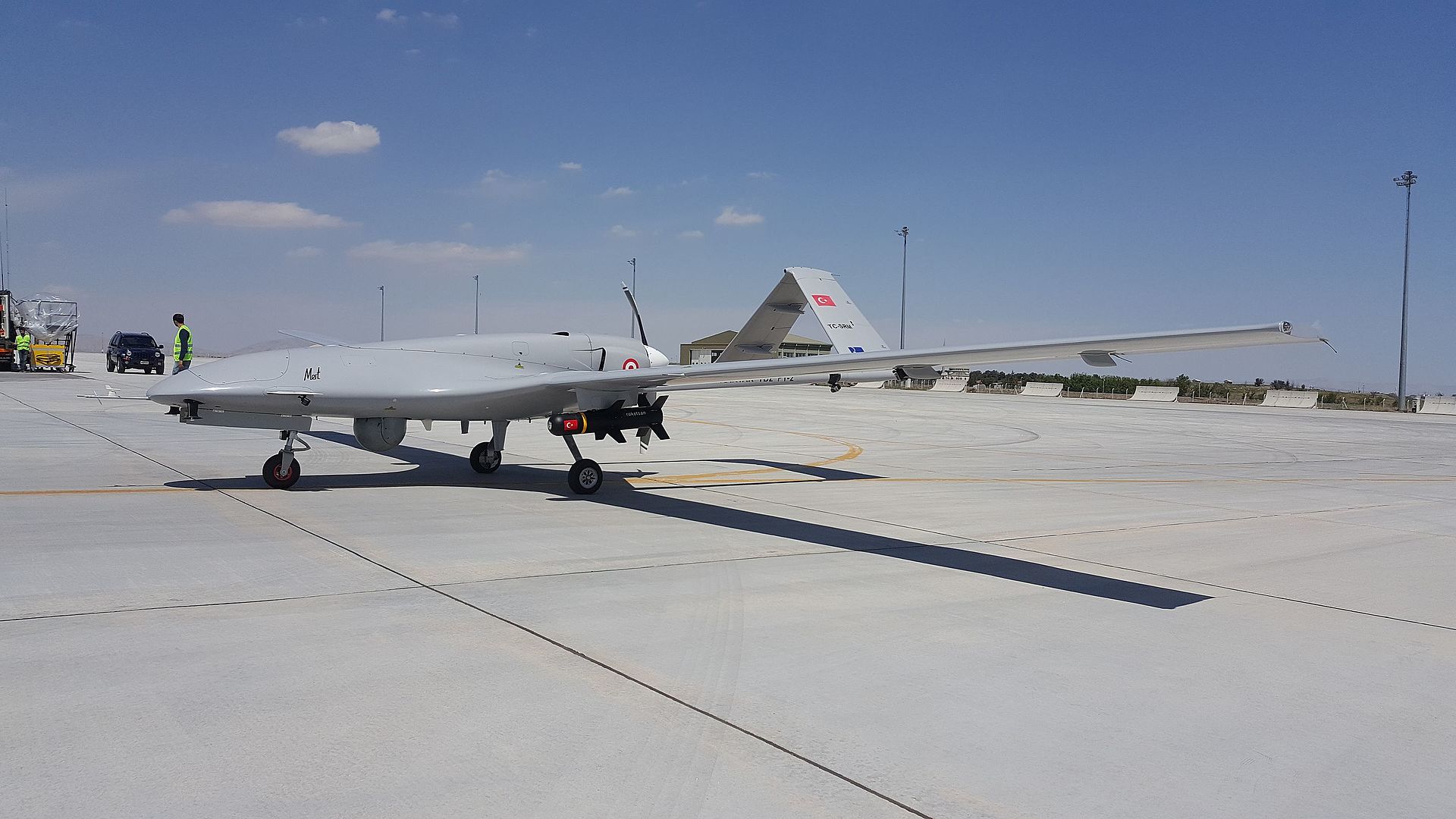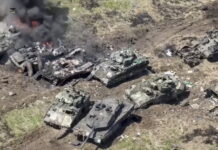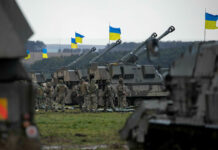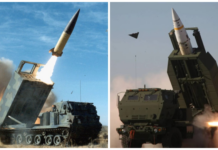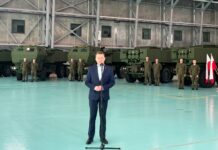Since Russia began their invasion on 24 February 2022, there has been a continued tendency on social media and in the press to hype up many Western weapons supplied to Ukraine, often after seeing limited footage of their employment in narrow tactical scenarios. This has often resulted in the fetishisation or even canonisation of weapon systems in the public sphere – see ‘Saint Javelin’[1], ‘Saint NLAW’, ‘Saint Stinger’, along with songs honouring the Bayraktar TB2 UAV[2] and HIMARS[3] rocket artillery system. However, despite the undeniable effectiveness of most of these systems in their roles, much of the initial hype around them as battlefield game-changers has gradually dissipated as the war failed to end, and the public imagination’s search for the next wunderwaffe continued.
The reality, as usual is much more complex and nuanced than it typically appears online. In part this hype is generated by a tendency toward myopic focus on individual weapon systems and small-scale tactical victories. Considerably less attention has been paid to combinations of different capabilities, operational conditions, and the significance of different tactical victories within the wider context of the war. This article examines some of the Western systems delivered to Ukraine, and why many observers’ expectations have failed to align with reality.
The wunderwaffe that weren’t
The Bayraktar TB2 was heralded as a game-changer in the opening weeks of the war, when there was ample footage of UAV strikes on Russian motorised and mechanised columns in transit. These initial glimpses seemed to demonstrate that the UAV could be just as effective in Ukraine as it was in the 2020 Nagorno-Karabakh conflict. However, by the fourth week the quantity of strikes had fallen dramatically, and by the fifth week (24 March) Bayraktar TB2 strikes had dropped to zero, where they remained until Ukraine carried out a series of attacks on Snake Island in early May[4] using both manned aircraft and the TB2, and then again in early July[5]. Even without the slow trickle of photographs showing downed[6] TB2s emerging in the following weeks and months, the rapid drop in reported strikes in the fifth week was a strong indicator that the majority of TB2s had been downed[7], most likely by a combination of Russian air defences and Russian aircraft, with very few estimated to remain at that point in time. This in turn led to Ukraine becoming more conservative with the use of their remaining TB2s. This assessment has been largely borne out by evidence gathered over several weeks spent in Ukraine by RUSI’s Dr Jack Watling, during which time Watling interviewed many serving members of the Ukrainian armed forces. Watling stated in the ‘This Means War’ podcast released on 30 June that “There are a lot of capabilities, like UAVs of all classes that are just not surviving. The lifespan of a Ukrainian UAV is maybe a week, at best.”[8]
Another Bayraktar TB2 UCAV operated by Ukraine has been reportedly shot down by Russian air defenses over Kozinki in the Belgorod Oblast of Russia. pic.twitter.com/xNAou9raAK
— Status-6 (@Archer83Able) April 27, 2022
Likewise, the arrival of HIMARS was met with considerable hype, and the system quickly proved itself to be effective at striking distant and operationally-vital targets such as command posts and ammunition caches. Yet more than two months after its initial employment, the tempo of GMLRS strikes on critical targets appears to be gradually slowing down as the Russians adapt. Partially, this may be down to fire missions having caught up to the intelligence cycle – many known targets have already been hit and more intelligence-gathering work and planning will need to be done to find their replacements. It is a little early to make a general assessment, however, there are already some indications that the Russians have begun to find ways of decreasing HIMARS’ effectiveness.
One possible indicator of Russia’s adaptation has been the number of successful strikes on Kherson’s Antonivskiy Bridge, a critical piece of infrastructure in Russian hands providing them with access across the Dnipro river. In the aftermath of initial GMLRS strikes on the bridge on 19 and 27 July[9] 2022, the bridge appeared to have suffered meaningful damage, with approximately five holes shown in footage after the 19 July strikes, and nine or ten holes evident[10] after the 27 July strikes. Russian forces then made efforts to repair[11] the bridge in order to maintain their primary supply line into Kherson, resulting in Ukraine carrying out further strikes on 8 August. However, this time the damage seemed far more superficial, with approximately four smaller holes[12] in the bridge, along with damage to Russian construction equipment.
It would seem the Ukrainian forces also considered the damage insufficient, given that they targeted the bridge with another round of strikes on 14 August. In video footage[13] of the attack, three explosions from what were presumably GMLRS impacts were evident, along with equipment on the bridge burning at the start of the video, suggesting at least four successful impacts on the bridge. While the short clip almost certainly does not tell the entire story, it is sadly one of the only pieces of evidence of the incident publicly available for analysis.
Красивое – Антоновский мост. pic.twitter.com/wRq3gRxQsH
— Алексей Иванов (@aujvanov) August 14, 2022
The footage appeared to indicate at least one interception of a GMLRS rocket by Russian air defences, though it is difficult to evaluate success from this footage alone. Aside from the limitations imposed by low-resolution, low-framerate cameras, attempting to count the telltale twin-fireballs of two warhead detonations is not the most reliable method for judging successful interceptions. This is because interceptions do not always destroy the warhead of the rocket. An interception may instead cause damage to the rocket’s stabilisers, control surfaces, or guidance system, thus changing its trajectory and resulting in the rocket failing to reach its target, typically falling elsewhere. Such interceptions are less tidy and less easy to spot than those resulting in warhead destruction, but they usually still get the job done. However, to an outside observer, the missile may appear to have survived intact, complicating the task of assessing the interception’s success or failure. This effect can also be exploited by the opponent for propaganda value, to claim more successful strikes on target than there actually were.
In the absence of hard visual evidence of interceptions, the next-best method for determining their likelihood is assessing the aftermath of strikes. Here, the lower quantity of recorded impacts on the bridge in August compared to July is perhaps the most telling sign that not all GMLRS rockets launched are reaching their targets. Given that there has been no evidence to suggest that Ukraine has suddenly decided to opt for launching smaller salvos, nor that Ukraine’s GMLRS rockets have been experiencing an unusually-high failure rate, the most likely explanation is that some of them are being intercepted.
This seems to be further supported by the fact that the bridge was targeted with a further round of strikes on 25 August.[14] These strikes do not appear to have rendered the bridge unusable either, as footage from the next morning showed Russian forces continuing to use the bridge.[15]
ANTONOVSKY BRIDGE THREAD ?
/1
*starting from now in attempt to create some kind of order all info regarding bridges will be attached to the threads*Today at about 5 am there were once again strikes on Antonovsky bridge area. A fire started as a result on southern bank. pic.twitter.com/VpXXa3ACM4
— Special Kherson Cat ??? (@bayraktar_1love) August 25, 2022
However, a series of several strikes carried out on 26 August seemed to have damaged the bridge sufficiently to at least temporarily prevent its use. Although little information is available on the nature of the munitions used in these strikes, the close grouping of holes would suggest the bulk of hits were probably caused by GMLRS, possibly supplemented by other munitions.[16]
The search continues
By early August, two further weapons began to receive attract speculation as the next potential game-changers for Ukraine. The first of these was the AGM-88 High-Speed Anti-Radiation (HARM) missile, following US Undersecretary of Defense for Policy Dr Colin Kahl’s 8 August announcement[17] that the US had provided Ukraine with air-launched anti-radiation missiles. The Pentagon later confirmed[18] that these were AGM-88 HARM, and that they had already been integrated on Ukrainian aircraft and employed by Ukrainian forces. This confirmed speculation dating from early August that Ukraine had begun to use HARMs, following images of a HARM wreckage in Ukraine surfacing on social media.[19]
Russian channels have posted images of what appear to be the remains of an AGM-88 HARM antiradiation missile. A fragment of the HARM’s BSU-60A/B stabilization fin can be seen in the wreckage.
The missile was reportedly fired at a Russian position. pic.twitter.com/GCNA55CJdj
— OSINTtechnical (@Osinttechnical) August 7, 2022
The second was the AGM-140 Army Tactical Missile System (ATACMS), which emerged as an early suspect in the 9 August strikes[20] on Saky airbase in Crimea, a charge which was denied by a Pentagon spokesperson during a 12 August briefing[21], with the spokesperson stating that the US has not provided Ukraine with ATACMS, nor any weapon capable of reaching Crimea. Ukraine has requested[22] ATACMS, and although the US’ primary reason for not providing ATACMS was reported[23] to be its potential for Ukraine to launch attacks on Russia proper, there are also precious few reasons to believe that the missile would become a real game-changer for Ukraine.
For starters, ATACMS would broadly play to the strengths of Russia’s air defence systems. Compared to the smaller and shorter-range M31 series GMLRS rockets Ukraine has been using so far with its HIMARS systems, ATACMS must necessarily fly higher as a function of its greater range and ballistic trajectory. On top of this, the missile is much larger than a GMLRS rocket and has a larger radar cross-section (RCS), meaning that the range at which Russian radars will be able to detect it, and hence respond will be greater. Together these factors would increase Russian Air Defenders’ window of time to react and would expose the missile to possible interception by Russia’s longer-range air defences, such as the Buk, S-350, S-300P, S-300V, and S-400 families.
Secondly, by virtue of its size the ATACMS necessarily has much weaker saturation potential than the GMLRS, with battery of four HIMARS capable of launching either four ATACMS, or 24 GMLRS. For the Russian air defences, it would be much easier to intercept a salvo of four large, high-flying targets with a larger RCS than 24 smaller, lower-altitude, lower-RCS targets. Beyond being easier to shoot down, the adoption of ATACMS would impose some other negatives onto on the Ukrainian side. A battery of ATACMS-equipped HIMARS would be able to engage far fewer targets per salvo, and would require much more frequent reloading, greatly decreasing their combat uptime. Additionally, frequent reloading would require the platforms to spend more time in once place, where they may be vulnerable to enemy strikes.
The primary advantage of ATACMS would be the ability to engage more distant targets, however exploiting this to the full would require good knowledge of Russian air defence positioning in order to avoid the missiles being engaged. While this could theoretically be possible with Ukraine’s access to US intelligence, such strikes would require more planning than GMLRS, whose saturation potential allows it to be used more flexibly. As such, in most tactical situations Ukraine would benefit more from additional GMLRS rather than ATACMS, because volume and saturation potential are more important than range within Ukraine’s operational context.
HARM is likewise probably not a silver bullet in the context of Ukraine. On paper, it is a useful tool for dealing with air defences, but in practice there are a number of obstacles which prevent Ukraine from using the weapon to its fullest potential in this particular role.
For starters, assuming the integration with Ukraine’s aircraft resulted in no major issues, there is the issue of training Ukrainian pilots to use it effectively in the Suppression of Enemy Air Defences (SEAD) or Destruction of Enemy Air Defences (DEAD) roles. This would require time and impose an opportunity cost, since a squadron going through training in such highly specialised mission types could not be expected to participate in other missions at the same time. Secondly, even with HARM integrated, Ukraine’s aircraft lack AN/ASQ-213 HARM Targeting System (HTS) pods, without which targeting HARM effectively can be difficult, according to a former US ‘Wild Weasel’ pilot.[24]
Furthermore, undertaking SEAD/DEAD missions would require Ukraine’s air defences to be able to reliably carry out airspace deconfliction to avoid fratricide.[25] This would not be straightforward, given that Ukraine’s air defences broadly lack the C2 sophistication for reliable deconfliction and operate in a contested electromagnetic (EM) spectrum environment. Additionally, portions of Ukraine’s air defences are reliant on distributed MANPADS teams without access to a C2 network, and largely reliant on visual target confirmation, further complicating deconfliction.
Lastly, HARM itself has been criticised by some former US pilots, who have stated that it is difficult to use due to the attitude of the aircraft at launch affecting the accuracy of the HARM’s inertial navigation system (INS), and for the missile losing accuracy after air defenders turn their radars off.[26] Pilots have also stated that warhead is insufficiently large for the weapon’s relatively low level of precision, sometimes resulting in damage to the target rather than destruction, making it overall less desirable than other weapons for engaging air defences.[27]
Even without these challenges, executing the SEAD/DEAD mission set against Russian air defences would be still extremely risky, and Ukraine’s armed forces fully understand the danger they pose, as noted by Dr Jack Watling on the ‘This Means War’ podcast:
“The air side is, I think, an interesting picture, and this comes back to that point about people not understanding Russian weapon systems. The Russian Air Defence systems work, and they are as problematic as we thought they were against fourth-generation platforms. They are lethal, highly effective, and rather like Russian electronic warfare is a huge enabler of the Russian Forces because it just denies the airspace. The Ukrainian planning assumption is: fly target drones into an area, if it gets lit up by air defences, don’t go there with aviation or fast air.”[28]
For these reasons, the most viable way for Ukraine to employ HARM (depending on the variant) would probably be as an enabler for strikes from other weapons. In this role, the HARM would not be employed for serious SEAD/DEAD missions, but would instead be air-launched blind toward a target area containing Russian air defence systems. At the same time, other munitions, such as GMLRS rockets, would target the object being protected by the air defence systems.
Employed this way, the HARM would be launched in a ‘pre-briefed’ mode in which the missile flies toward a designated area while the seeker searches for radar emissions in-flight.[29] Upon detecting the HARMs, Russian air defences are incentivised to shut off their radars or switch to a reduced-capability mode, making it significantly more difficult for them to carry out interceptions of the other munitions on their way to the target. Russian short-range air defences may also attempt to intercept the HARMs, but even if they are successful, HARM will have done its job. This is because HARM’s presence in the mix of threats will increase the overall number of targets Russian air defences have to deal with and will have caused them to expend ammunition on less-important targets.
This means of employing HARM would be unlikely to result in many casualties among Russian air defences, but would probably result in more of Ukraine’s other munitions reaching their targets. This would also be a noteworthy example of Ukraine layering their strike capabilities to better adapt to and shape the operational conditions of the battlefield. However, to many outside observers this valuable effect would be largely invisible.
A long road ahead
Observers would do well to remember that there is much of the war they can’t see, and that images or video footage should be treated with caution. Each one is like a single pixel in a much larger obscured image, and they are often presented by actors with their own political perception-oriented goals. The War in Ukraine is as much a propaganda war as it is a kinetic war, and neither side regularly release footage of their own equipment being destroyed, nor regularly report combat casualty figures. There are very good reasons for doing so – not only is it bad for domestic morale, but in Ukraine’s case keeping the international community’s flow of equipment, training and support going requires convincing them that this war is winnable. Reporting their own side’s losses is therefore counter-productive to achieving this goal because it could cause international confidence to waver.
Consequently, there will often be major discrepancies between the effectiveness of weapons in the lived experience of soldiers and the public perception of their effectiveness. This focus on individual weapon systems also tends to skew attention away from the bigger picture. Fundamentally, many of the armaments delivered to Ukraine have largely helped Ukraine’s soldiers to be better at doing what they can already do. As the Donbas conflict from 2014-2022 showed, Ukraine has not struggled to knock out individual Russian tanks or armoured vehicles in a defensive war. Footage of their capacity to do the same thing with NLAW or FGM-148 JAVELIN does not provide any particularly meaningful insights, and draws attention away from the serious operational challenges they face ahead.
What Ukraine lacks more than any single weapon system is the freedom to mass their forces for meaningful counteroffensives which can influence the wider balance on the battlefield. Here Russia’s artillery has served in a crucial, but largely invisible capacity, preventing Ukrainian forces from massing together by its presence. It has done so in spite of many of its systems being older or sometimes less accurate than their Western counterparts. This has had a profound impact on the war, because it has restricted Ukraine’s freedom to do what it needs to do in order to win.
There is no individual wunderwaffe that can resolve this problem, however there are potential combinations of different weapons, operational practices, and tactics which could allow Ukraine to gradually shape the battlespace in their favour over time. Long-range precision fires in the form of HIMARS was a start in this direction, and HARM would seem to be a means of reinforcing that. However, these capabilities alone cannot be expected to shift the balance. Unless they are coupled with effective practices and tactics which change the underlying conditions of the battlespace, they will merely inconvenience their opponent rather than dealing a decisive blow.
Mark Cazalet
[1] https://www.saintjavelin.com/
[2] https://www.youtube.com/watch?v=S3FGWPMjl6M
[3] https://www.youtube.com/watch?v=_e2QFDDMqwc
[4] https://www.navalnews.com/naval-news/2022/05/surprising-success-of-ukraines-bayraktar-tb2-the-ghost-of-snake-island/#prettyPhoto
[5] https://www.thedrive.com/the-war-zone/russia-ukraine-take-turns-bombing-snake-island
[8] https://sites.libsyn.com/420071/ukraine-as-at-27-jan-22-could-this-be-a-turning-point, Timestamp: 00:36:08 – 00:36:17
[9] 19 July – https://www.youtube.com/watch?v=xglYlqljebE, 27 July – https://twitter.com/michaeldweiss/status/1552284197221539841
[10] https://www.dw.com/ru/155j-den-vojny-rossii-protiv-ukrainy-glavnye-sobytia/a-62632942
[11] https://www.youtube.com/watch?v=79unuR2m6tM, https://twitter.com/RALee85/status/1553702810826715136
[12] https://www.youtube.com/watch?v=79unuR2m6tM, https://odessa-journal.com/antonovsky-bridge-fresh-photos-after-himars-attack/, https://mobile.twitter.com/TpyxaNews/status/1556952512174985216/photo/1
[13] https://twitter.com/bayraktar_1love/status/1558720653347487745, https://twitter.com/aujvanov/status/1558845067179302913
[14] https://twitter.com/bayraktar_1love/status/1562714354557997058
[15] https://twitter.com/bayraktar_1love/status/1562714811066068993
[16] https://twitter.com/ArtisanalAPT/status/1564285451996897280, https://twitter.com/ArtisanalAPT/status/1563267758061948930, https://twitter.com/bayraktar_1love/status/1563277689934721026
[17] https://www.defense.gov/News/Transcripts/Transcript/Article/3120707/usd-policy-dr-kahl-press-conference/
[18] https://www.defense.gov/News/Transcripts/Transcript/Article/3134558/senior-defense-official-holds-a-background-briefing/
[19] https://twitter.com/Osinttechnical/status/1556334462480392193
[20] https://twitter.com/ELINTNews/status/1556989234052997122
[21] https://www.defense.gov/News/Transcripts/Transcript/Article/3127068/senior-military-official-holds-a-background-briefing/
[22] https://www.thedailybeast.com/lawmakers-want-better-weapons-for-ukraine-joe-biden-isnt-so-sure, https://www.washingtonpost.com/national-security/2022/07/24/ukraine-himars-russia-us/
[23] https://www.washingtonpost.com/national-security/2022/07/24/ukraine-himars-russia-us/
[24] https://www.fighterpilotpodcast.com/episodes/113-wild-weasels/ Timestamp: 53:11 – 53:18
[25] https://www.jcs.mil/Portals/36/Documents/Doctrine/pubs/jp3_52.pdf see p32-42
[26] https://www.fighterpilotpodcast.com/episodes/113-wild-weasels/ Timestamp: 0:29:15 – 0:29:39, Timestamp: 0:41:08 – 0:44:20, Timestamp: 1:24:35 – 1:26:40
[27] https://www.fighterpilotpodcast.com/episodes/113-wild-weasels/ Timestamp: 0:41:08 – 0:44:20, Timestamp: 1:24:35 – 1:26:40
[28] https://sites.libsyn.com/420071/ukraine-as-at-27-jan-22-could-this-be-a-turning-point Timestamp: 00:25:22 – 00:26:57
[29] https://www.vaq136.com/ea6bharm/


